Prague is bursting at the seams with things to do, even after the museums and galleries have shut. Highbrow pursuits rival opportunities for more frivolous entertainment. Whether you choose to bask in the city’s rich musical heritage or simply enjoy a glass of pilsner in one of its legendary beer cellars, this is one city where there really is something for everyone.

A performance by the Prague State Opera Ballet
Bigstock
Kafka, Back in the Limelight
Like a great number of the central figures in the history of Prague, Franz Kafka spoke German. This factor lost him the support of the Czech public when the country rid itself once and for all of Austro-Hungarian state supervision in 1918, and again in 1945 when the German minority was expelled. The author of The Castle, The Trial and Metamorphosis was equally banished by the communist regime for being a bourgeois intellectual.
But Kafka is firmly back in fashion. The place of his birth at U Radnice 5 bears his name, and a small exhibition (Tue–Fri 10am–6pm, Sat 10am–5pm) reveals his life and work. The more ambitious Franz Kafka museum (Cihelná 2b; www.kafkamuseum.cz; daily 10am–6pm) uses multimedia displays to explore the writer’s background, emphasising the influence of personal experiences on his books.
Entertainment
Prague is home to a multitude of theatre, ballet and opera companies, with a strong tradition of puppetry and mime. However, it is undoubtedly in the field of classical music that it has established itself as a world leader, as its wealth of concert venues and its packed musical programme will testify.
Music and theatre
The city has been a major concert venue for at least five centuries. It greeted the premiere of Mozart’s Don Giovanni and played host to numerous major composers during their careers. Large concert halls have been built during various periods in the history of Prague and today, along with a host of smaller venues, they provide a welcoming home for concerts all year long.
The city is home to some very fine classical ensembles, foremost of which is the Czech Philharmonic Orchestra (www.ceskafilharmonie.cz), one of the finest in the world. Others include the Prague Symphony Orchestra (www.fok.cz) and the Prague Radio Symphony Orchestra (www2.rozhlas.cz/socr). These, and touring ensembles, appear at venues such as the Rudolfinum (www.rudolfinum.cz, tel: 227 059 227) or Smetana Hall at the Municipal House (www.obecnidum.cz, tel: 222 002 101). Lesser-known touring outfits or smaller groups, for example quartets, often perform at the Clementinum or St Nicholas Church to name a couple of venues.

Dvořák’s works top the bill in Prague’s concert halls
Public domain
Throughout the year large-scale festivals devote themselves to the work of particular composers or specific musical styles. The best of these are the Prague Spring (www.festival.cz) and Prague Autumn. Favoured composers include Czech heroes such as Dvořák and Smetana and hearing their music in their homeland is an experience not to be forgotten.
Concerts are held at lunchtime and in the evening and you can purchase seats from the ticket sellers in Old Town Square. Alternatively, head to the box office of the venue in question. With ticket prices representing such good value there is the potential to see a different performance each day – and many people do just that.
It is cheaper to buy tickets for events from the box office concerned, but if that proves impossible tickets are usually available via Ticketpro (www.ticketpro.cz) from numerous points around the city, including all the Prague Information Service offices (for more information, click here), Bohemia Ticket (www.bohemiaticket.cz) at K + K Hotel Fenix, Ve Smečkách 30, and at Ticketpro itself in the Lucerna Passage off Wenceslas Square.
The city is also home to the Czech National Theatre, ballet and opera companies, and regularly welcomes touring groups. The National Theatre (tel: 224 901 448; www.narodnidivadlo.cz) is an enormous complex with several stages, and encompasses the national opera and ballet companies. It also includes the Laterna Magika (tel: 224 901 417), one of the major European troupes and at the forefront of multimedia theatre. This popular genre blends music, mime, ballet, surrealism and satire into a powerful melange that transcends the language barrier. Each season, Estates Theatre (tel: 224 901448; www.narodnidivadlo.cz) also plays host to several companies, and the State Opera (tel: 224 227 266; www.czechopera.cz) stages seminal opera, ballet and dance productions.
Marionette performances take place at the National Marionette Theatre (tel: 224 819 322; www.mozart.cz). You can watch the puppets run the gamut of emotions in sophisticated plays of a more serious bent, or clown around in light-hearted pieces.
Useful listings of what’s on during your stay in the city can be found on the website www.ceskakultura.cz and are included in the English-language Prague Post newspaper (www.praguepost.com).
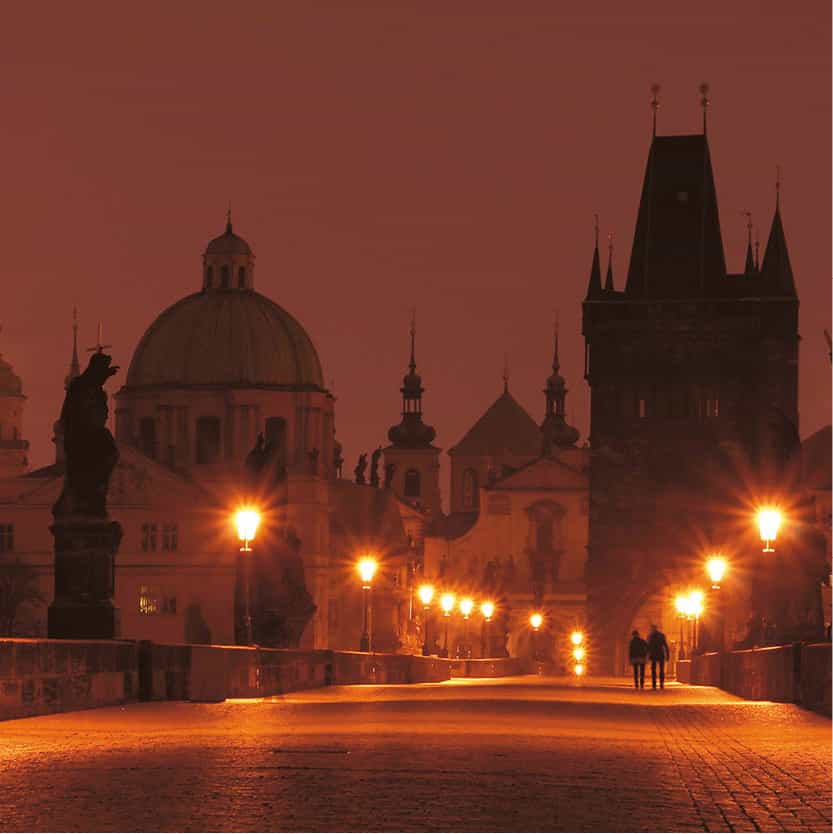
Prague’s perfect stage set: the Charles Bridge at night
iStock
Nightlife
If cultural overload strikes, why not seek refuge in Prague’s plethora of bars and cafés where you can enjoy a few drinks and listen to live rock, jazz or folk music. For a glass of local beer head for one of the city’s huge beer cellars. However, on a warm summer’s evening, try to find a bar terrace with a view over the city.
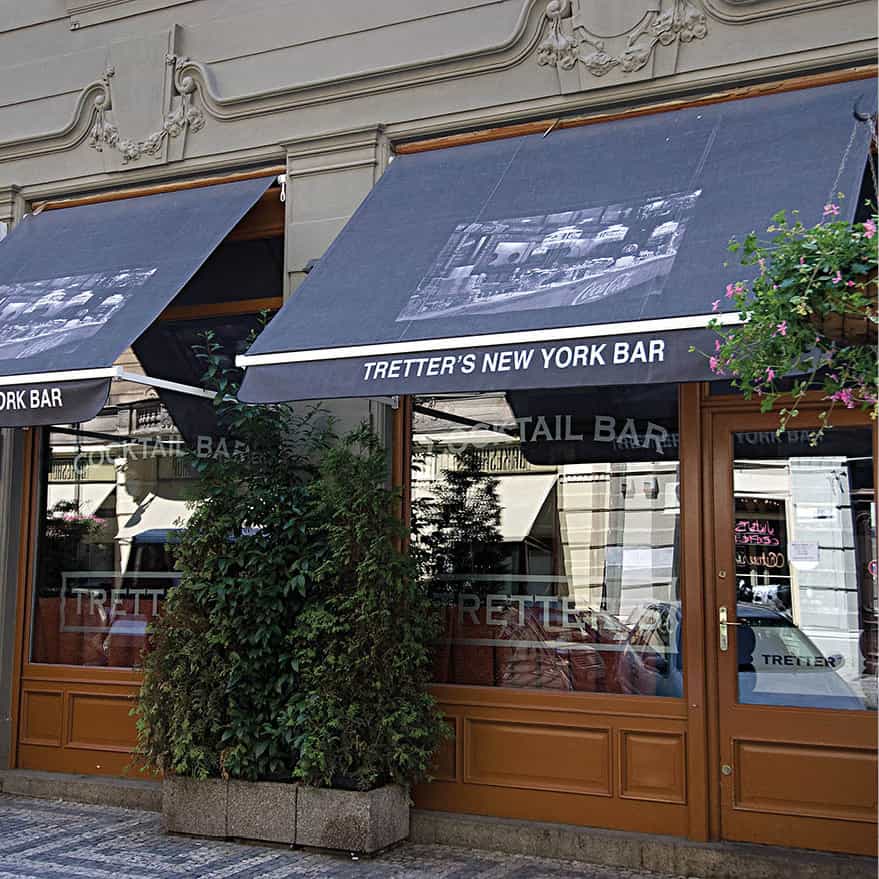
Tretter’s New York Bar
Rod Purcell/Apa Publications
A city that is so famous for its beer has to be a good place to have a drink and a pub or beer hall can be a convivial place to spend an evening. For well-kept beer and cosy surroundings try U Hrocha (Thunovská 10) and U Kocoura (Nerudova 2), both in Malá Strana, or the rather touristy U Zlatého tygra (Husova 17; www.uzlatehotygra.cz) in the Old Town or Zlý časy (Čestmírova 5; http://zlycasy.eu). Perhaps surprisingly Prague is also home to number of chic cocktail bars including Cloud 9 (Hilton Prague, Pobřežní 1; www.cloud9.cz) with breathtaking views over the city, Bugsy’s (Pařížská 10; www.bugsysbar.cz), Tretter’s (V kolkovně 3; www.tretters.cz) and Ocean Drive (V kolkovně 7). Žižkov is famous for its pubs and the suitably loud and seedy U vystřelenýho oka (U božich bojovníků 3; www.uvoka.cz) is a good place to get a feel for the area.
As the evening wears on, Prague’s lively nightlife kicks in. Trends can be short-lived, so keep an eye on the local press or websites such as www.techno.cz for the most popular club nights. For a relatively safe bet head for Prague’s most long-standing club, Radost FX (Bělehradská 120; http://radostfx.cz). Still very stylish, this venue attracts the cream of the local DJs, not to mention international guest DJs, and holds a gay night once a week. Other places you might want to check out include the popular and well-dressed Celnice (V celnici 4), Mecca (U Průhonu 3; www.mecca.cz) that also holds jazz nights, and Roxy (Dlouhá 33; www.roxy.cz) for house and R&B.
While the Prague gay and lesbian scene is fairly small there are some good venues to check out. The long-established mixed bar Friends (Bartolomějská 11; www.friendsclub.cz) is a good place to start, as is 21 Klub (Římská 21; www.klub21.cz). Clubs to try include the mixed TERmix (Třebízského 4a; www.club-termix.cz) or the gay Alcatraz (Krakovská 19; http://mujalkac.webnode.cz).
Shopping
The last three decades have seen huge changes in how and where people shopped in the city. This is one area where Prague has completely broken away from its communist past of limited goods in state-owned department stores. Today, shopping here is an experience much like that in any other European city, with an array of quality goods and traditional handicrafts.
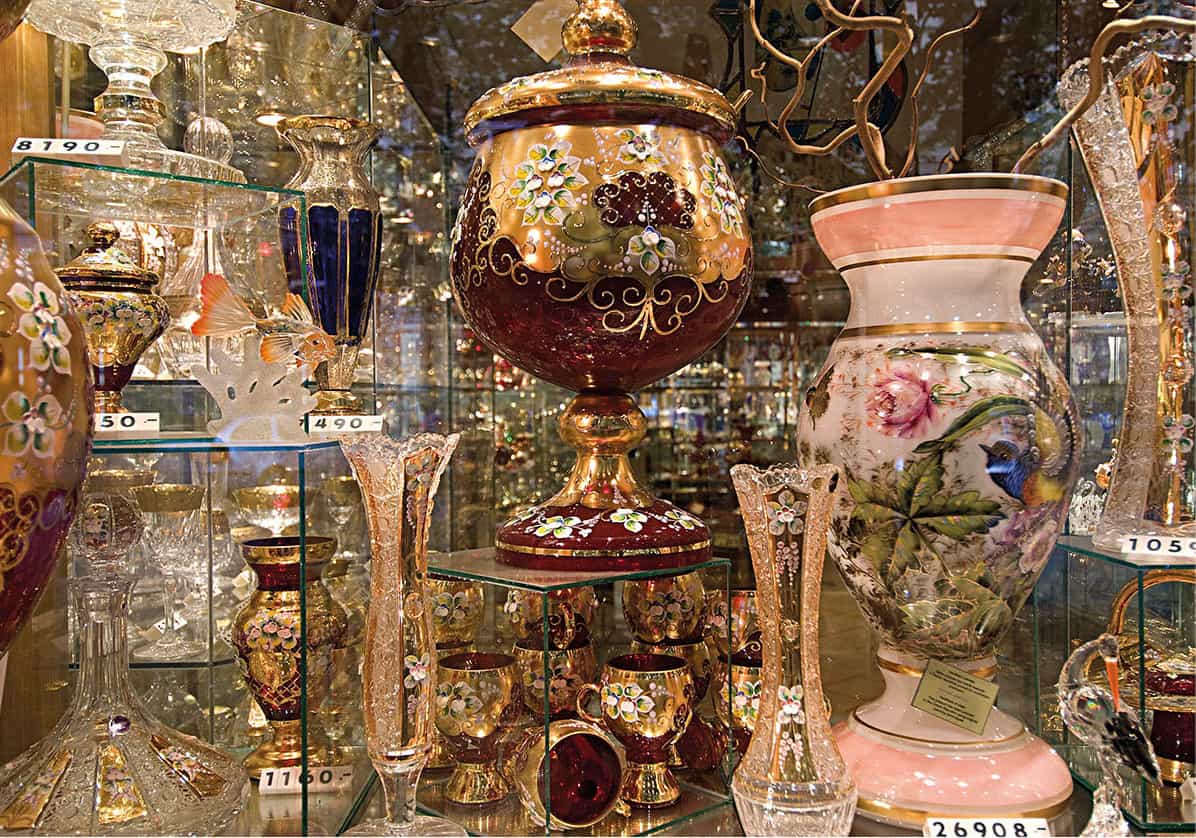
A shop window in the Old Town sparkles crystal
Rod Purcell/Apa Publications
The main shopping streets boast the flagship stores of all the well-known, international chains. However, by venturing into the Old Town you will come across small, specialist shops.
Do remember to check whether stores take credit cards. Although payment by credit card is widespread, it is by no means universally accepted.
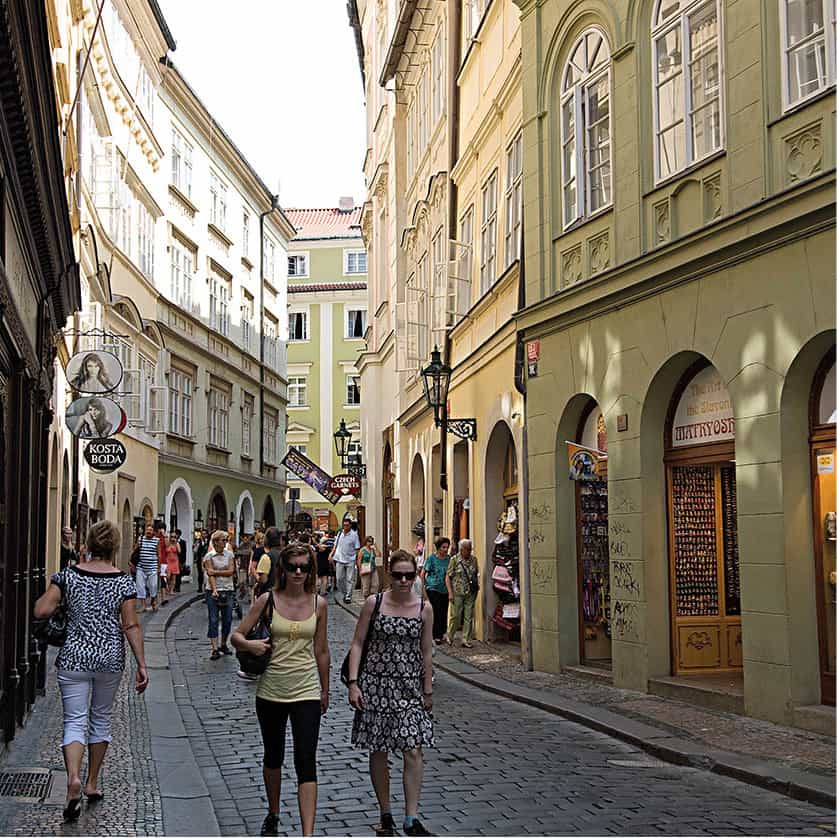
Shoppers in the Old Town
Rod Purcell/Apa Publications
Where to shop
The majority of the souvenir shops can be found along the ‘royal way’ leading from Municipal House through the Old Town Square, and in Lesser Quarter Square across the river. Big names from the (Western) high street have set up shop around Wenceslas Square and along Na příkopě, whereas on the more up-market streets of Pařížská and Jungmannova, European haute couture rubs shoulders with the emerging Czech designer labels.
A good place to shop for souvenirs is the Týn Court (Týnský dvůr or Ungelt), just behind the Týn Church. Here you’ll find books, fashion items, wines to taste, and cafés and restaurants in which to take a break.
What to buy
The Czech Republic has a reputation for the quality of its traditional products. Glasswear and porcelain are particularly renowned and examples of both are to be found in royal collections across Europe. Bohemian Crystal is an exclusive brand name despite having factories scattered throughout the country. Lead crystal ranges in lead content from 14 percent to 24 percent and comes in myriad shapes and patterns. Traditional decanters, vases, bowls and glasses, with patterns cut by hand, make pretty souvenirs or gifts and are to be had at roughly half the price of that in other European countries.
More modern designs in glasswear are also popular, from large, decorative sculptures to vases. Bunches of large glass flowers mimic the shape of fresh blooms.
The delicate features of Bohemian porcelain figurines have changed little in the past 200 years, and their flowing forms are highly prized among collectors. The best originate from small factories around Karlovy Vary, but they can also be bought in Prague. The Český Porcelán factory on the outskirts of town – which also has an outlet on site – is famous for its dinner services in its signature cobalt blue ‘onion’ design.
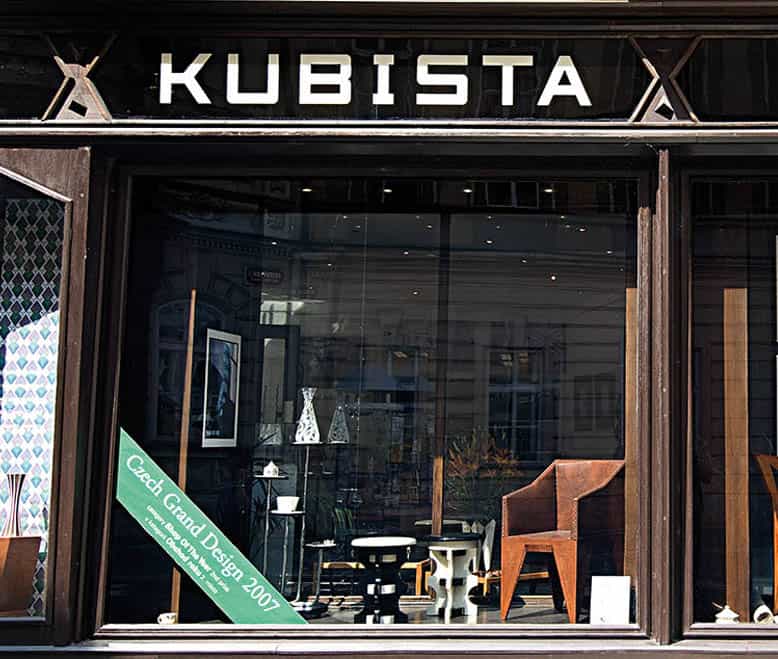
Cubist replica furniture at Kubista
Rod Purcell/Apa Publications
Prague has a reputation as being a city of the arts. There are numerous stalls selling – often rather dodgy – watercolours or line drawings of Prague. Moody black-and-white photographs offer yet another perspective of the city. Apart from these more obvious offerings, Prague also has several galleries selling works by both established and up-and-coming artists. For something a bit different have a look at the Cubist and Modernist replicas on sale at the Kubista (www.kubista.cz) and Modernista (www.modernista.cz) shops.
There are also a number of antiques dealers, with glass and porcelain being particularly prevalent. As a leading city of the Habsburg Empire, Prague counted a large number of wealthy and cosmopolitan citizens. These collections, along with a rich legacy of Bohemian furniture and artefacts, form the basis of today’s trade in antiques.
Garnets have been mined and polished in the Czech Republic for centuries, and the pretty, semiprecious stones can be bought in jewellers across the city.
Shops selling Czech handicrafts (try Manufaktura; www.manufaktura.cz) are often enticingly set in historic houses or converted cellars. Wooden toys make good presents for young children. Ceramics come in a variety of shapes and sizes, decorated with glazes made of earth pigments. In the Czech Republic, decorated eggs feature prominently in Easter celebrations and are widely available as souvenirs – coloured ribbons are attached so that you can hang them in your home. Marionettes make an original souvenir and come in a range of characters. The craft stalls of Josefov are appropriately laden with Rabbis. Finally, basketwear can be excellent although unfortunately the most beautiful items are often the largest and too bulky for the return flight home.
In a city where performances of classical music will feature prominently during your stay, it comes as no surprise that music is readily available, with some stores selling a huge range of classical recordings. CDs are inexpensive and look out especially for those of works by Smetana and Dvořák.
Bottles of the Czech pilsner beer are rather heavy to take home, but try a bottle of the heady Becherovka liqueur. Plum brandy or slivovice is also widely available, as are brandies distilled from other fruits.
Sports and activities
Spectator sports: Sparta Praha is the Czech Republic’s top football team. They play in a stadium (tel: 296 111 400; www.sparta.cz) adjacent to Letná Park and their season runs from September to April. Ice hockey is extremely popular, the main venue being HC Slavia’s O2 Arena stadium (tel: 266 771 351; www.o2arena.cz). The Czechs are naturally proud of the number of professional tennis players they have produced in recent decades. The National Tennis facility (www.cltk.cz) on Štvanice Island below the Hlávkův Bridge hosts Grand Prix tournaments.
Swimming: There are a number of pools in Prague. Plavecký stadion Podolí (Podolská 74; tel: 241 433 952; www.pspodoli.cz) is the largest pool complex in the city with two outdoor pools, one inside, diving boards and a waterslide. Aquacentrum Letňany Lagoon (Tupolevova 665; tel: 283 921 799; www.letnanylagoon.cz) has good safe areas for children.
Rides and cruises
Apart from walking there are a variety of different ways of seeing the city. Horse-drawn carriages carry you at a gentle pace through the cobbled streets of the Old Town; or opt for a ride in a vintage car; open-top, weather permitting. Both tours depart from Old Town Square.
Riverboats operating day or evening cruises ply the waters of the Vltava, with candlelit dinners and jazz bands for added interest. Boarding takes place on the Lesser Quarter bank just below Charles Bridge. See the website of the two best-known companies for details: the Steam Navigation Society of Prague (www.paroplavba.cz) and Pražské Benátky (www.prazskebenatky.cz).
During the summer months (April to mid-November, weekends and holidays), Prague’s historic tram 41 (www.dpp.cz) tours the city. The National Theatre, Malostranské náměstí and Wenceslas Square are all boarding points.
Children’s Prague
At first glance Prague seems to have little to offer children, the accent of a typical tour being on visiting the major churches, palaces and galleries. However, there are a few fun activities that will keep children happy and maybe even amuse parents.
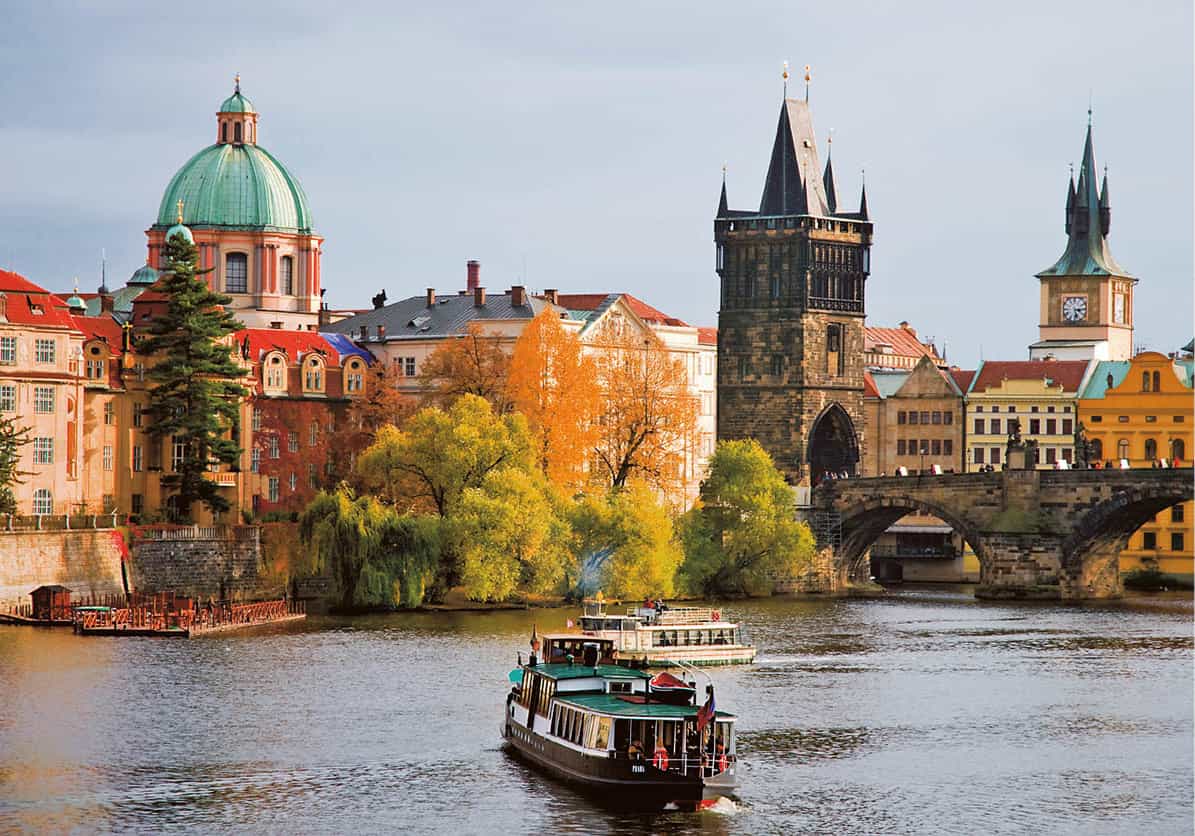
Boats on the Vltava
iStock
Transport can be entertaining. Ride in a horse-drawn carriage through the streets of the Old Town. Boat trips on the Vltava are also fun; take some bread to feed the ducks and swans. A simple ride on a tram can be a great experience in itself, and taking the funicular railway up to Petřín Hill is thrilling for children.
With a little advance planning, a well-chosen theatre trip can be a stimulating experience even for small children. The Lanterna Magika features dance, mime and the use of lighting effects. The National Marionette Theatre (tel: 224 819 322; www.mozart.cz) stages shows for all ages, including a puppet version of Don Giovanni.
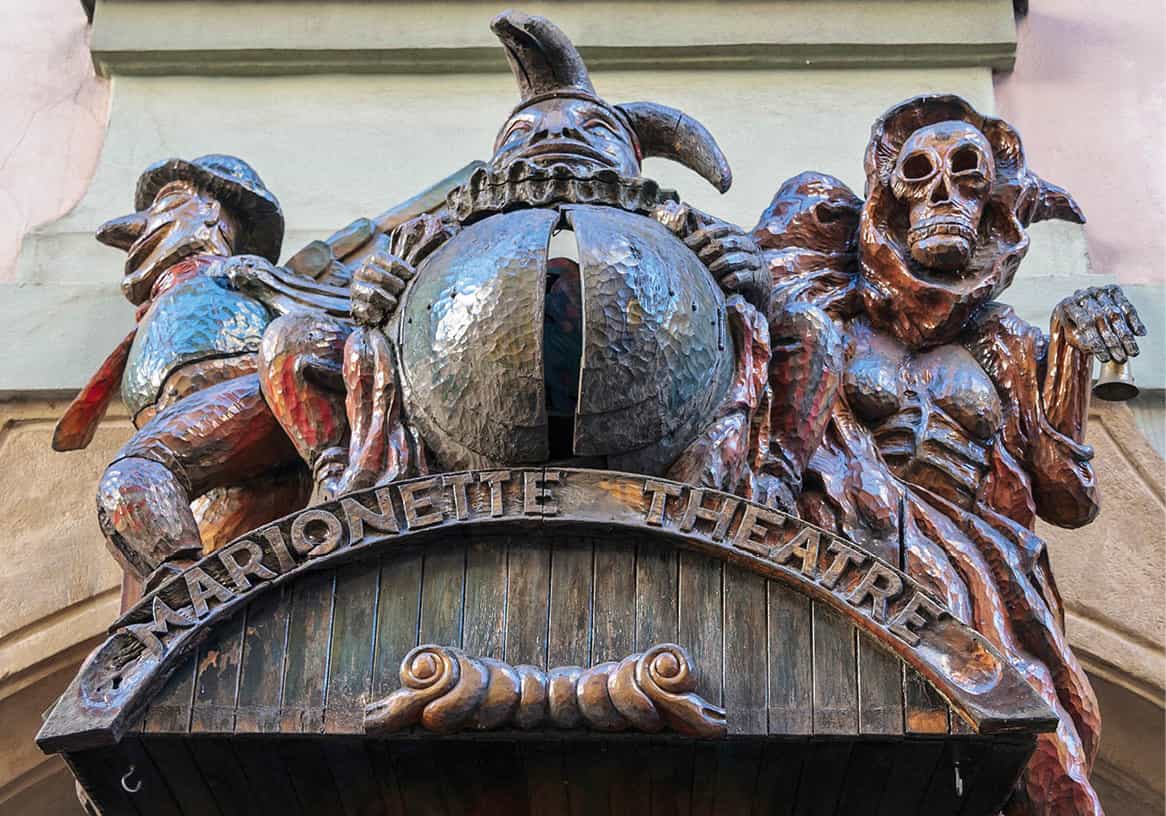
One of Prague’s numerous puppet theatres
iStock
If your child is mad about funfairs, a large one comes to the Prague Exhibition Ground during the summer months.
Child-friendly museums include the National Technical Museum, with plenty of interactive displays. The National Museum has collections of tropical insects and animal bones – children might be enthralled by the giant insects. The Toy Museum in the eastern part of Prague Castle will appeal with its large selection of toys from ancient Greece to the present day. Time your visit to coincide with the hourly changing of the guards in the first courtyard – most impressive at noon.
Kids love the Mirror Maze on Petřin Hill, although younger children may find it frightening. Bite-sized lunchtime concerts, held at venues across town, can be a great way of introducing children to classical music.